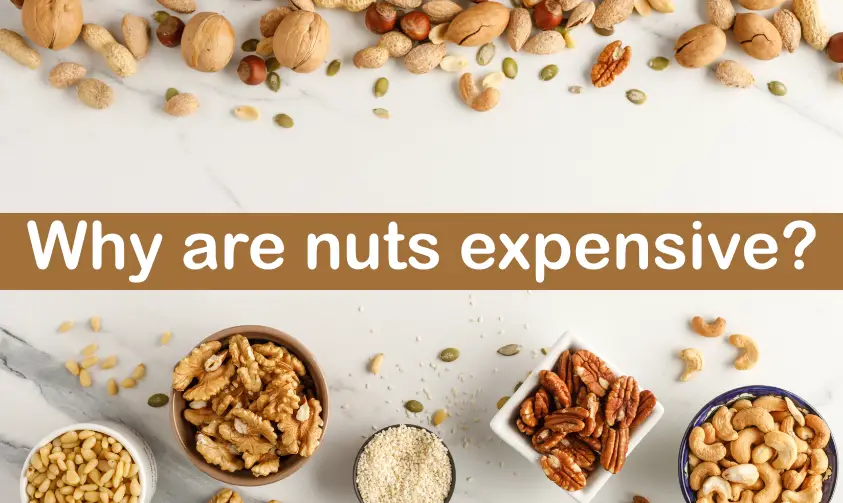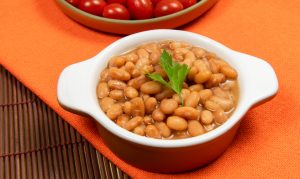In this article, you will learn why nuts are so expensive. I have covered various factors that affect the price of the nuts when it reaches the consumers.
But before we get started, let’s understand why nuts are popular.
Nuts have been a popular and nutritious food for many years. They are packed with protein, vitamin E, and fiber. Nuts are also high in calories.
One ounce of almonds contains roughly 160 calories, one ounce of pistachios 170 calories, one ounce of cashews 140 calories, and an ounce of macadamia nuts 230 calories.
The nutrition density combined with their high-calorie count means that they’re essential for people trying to maintain or lose weight or follow a healthy diet.
However, we all know that it is expensive and hence a challenge in adding them to our daily diet.
Here are the ten reasons why nuts are expensive.

Nut trees are very expensive to grow
The trees require large amounts of water and are especially vulnerable to cold temperatures during the blossoming and growing seasons.
The tree also requires a long time to grow, usually over five years. This is a longer time than most farmers are willing to wait for the first harvest of the nut trees.
Highly labour intensive
Nuts, especially pistachios, are highly labor-intensive; they require harvesting by hand.
Because harvesting nuts are expensive, it’s a job that’s nearly as well paid as working at the middle management or upper management positions in many other industries.
Because of this, there’s a constant shortage in the supply of people who want to harvest nuts. This makes the price of nuts much higher than the cost of simply growing and transporting them.
Nut markets are not easily accessible
Nuts are typically harvested from the nut trees in December through February when they’re at their most ripe and ready to be processed and canned.
The demand for nuts is greater in these months due to the winter holiday seasons.
Traders buy from growers or farmers at these times to make sure they don’t have too many nuts or no nuts at all, leaving them with a lot of inventory that they then must sell-off.
Because nut markets aren’t always easily accessible during harvest time, prices can fluctuate greatly.
Pricing varies by location
The price of nuts also can vary depending on the location in which they are purchased. Nuts that are grown domestically may be more expensive than imported nuts due to shipping and other fees.
Bulk sales and nut bars are often available at cheaper rates than individual packages of nuts, with these two options being your best bet for saving money when eating nuts.
High demand for nut ice cream
There’s a high demand for nut ice cream and other products. Pistachios are a popular ingredient in ice cream and many other foods because of their flavor.
But because they’re so expensive to grow, there aren’t very many out there to be consumed or enjoyed by people.
Transporting nuts is expensive
The distance between the production area and the processing plant can make transportation costs higher than that of many other food products.
These transportation costs are passed on to the consumer, raising prices in all areas.
High insurance and security costs
Nuts are a high-value product, meaning they’re of great financial value to the company producing them.
They’re also of great nutritional value and can be sold as a snack or incorporated into many food products, both of which make it more likely that they’ll be stolen by competitors or thieves once they enter the general market for sale.
This also means that thieves will be interested in taking these nuts.
Health regulations
While there’s a lot of risks involved in transporting and selling nut products as snacks, the potential for public health concerns associated with nut products is much greater than with other foods.
The nut industry has to adhere to strict government regulations regarding sanitation and food safety long before they ever reach the consumer.
This means that many nut products have to undergo long, expensive testing procedures at factories before they even begin production, or simply do not enter the market due to declining profits.
High taxes
The nut industry and the government, in general, must work together to ensure that the nutritional value of their product is not compromised, even after it’s sold.
Nut products are taxed by both the distributor and final consumer, increasing the amount needed to be made in order for a profit margin.
These taxes also increase over time as more people become aware of their health benefits and how much healthier they are than unhealthy mainstream foods.
Conclusion
In conclusion, there are many reasons why Nuts might be so expensive. There are many factors that go into making nuts so expensive and these are just a few of them.
However, the fact remains that most qualities of the nuts are very tasty and nutritious, making them a great food to add to your shopping cart. The next time you’re at the grocery store, satisfy your nut cravings with one of these great deals and save big money!
Related Question
Why are walnuts so expensive?
It isn’t easy to come up with a concise explanation for why walnuts are expensive. The main reason is that walnuts take up to two years to grow and also require a lot of resources, from water, fertilizer, and pesticides. In the end, they don’t yield as many nuts per year as more common tree nuts do.
The nut of the walnut is a very small seed, and it must be fully developed before it can be harvested. It takes up to two years for this to happen and covers most of the growing season in that time.
A big reason is that the walnut tree, Juglans regia, only grows in Asia. The best place for them is China, where they’re grown almost exclusively for nuts.
But the Chinese government forbids foreign ownership of trees in order to keep its market for nuts open.
The tree is a very big deal in China. It takes up to two years for the walnut to mature, and it can take up to 200 pounds of walnuts per acre. But it yields about 2,000 pounds of nuts per acre.
That’s because it only grows in one or two places and there are only a few thousand acres of trees available for farming them.
There’s more to the cost of walnuts than everything I mentioned above. There are also labor costs to consider, such as picking them and moving them around.
There’s more money to be made from selling walnut trees than from selling their nuts because they can be grown anywhere in the world.
However, farmers have to find a way to get around the Chinese government if they want to try growing their own walnut trees.
Finally, there’s the worldwide demand for walnuts and the limited number of them that can be grown. The United States is one of the biggest importers of walnuts, providing 25% of its demand.
What are the most expensive nuts in the world?
The world is full of expensive nuts, but that doesn’t stop people from buying them. In fact, many people enjoy having expensive nuts in order to feel special or pampered.
Almonds
Almonds are one of the most common nuts that people eat and they are also one of the more expensive ones.
A cup of whole almonds can cost up to $6 at a supermarket, making them significantly pricier than other options like cashews or walnuts.
Almonds were likely considered a luxury product due to their high demand for almond oil in cosmetics products and dishes.
In fact, the almond tree’s oil is used in everything from skincare products to cooking oils. Because of the high demand for almonds and their oil, nuts have become more common and available to people all over the world.
Brazil nuts
Brazil nuts are another expensive option that people enjoy eating. They are native to jungles in South America, where they grow on trees called Bertholletia excelsa.
The trees are located in one of the most remote spots on Earth. Farmers use helicopters and planes to transport the trees to cities where they can be sold. Because of the difficulty in shipping, Brazil nuts are quite expensive.
They can cost as much as $10 per pound in some areas of the world. The nuts are a wonderful addition to cakes and pastries, but they can also be enjoyed on their own as a snack.
Macadamia nuts
Macadamia nuts are also one of the more expensive nut options that people enjoy eating. The nuts grow on trees that are native to Australia, Papua New Guinea, and Hawaii.
The trees are fairly large and grow at a high elevation. Macadamia nuts are also rare because the trees only produce one crop per year.
The nuts do not ripen to maturity until they have fallen from the tree, so the trees have to be harvested by hand.
They can sell for as much as $400 per pound because of their expensive oil, which is used in cosmetics products and massage oils.
Macadamia nuts also taste better with age, so they are generally sold in bulk and enjoyed over time.
Price is a relative term when it comes to expensive food items. In some countries, a bag of pistachios can cost less than $2, while some people will pay more money for the same nuts in other areas of the world. Each country has its own set of pricing rules and regulations that determine how much certain items will cost.


